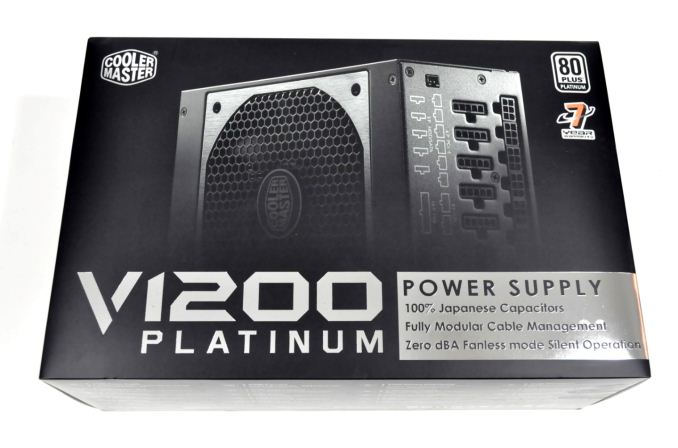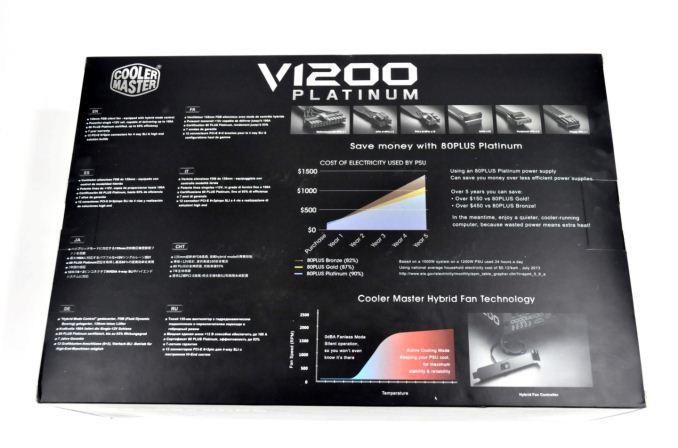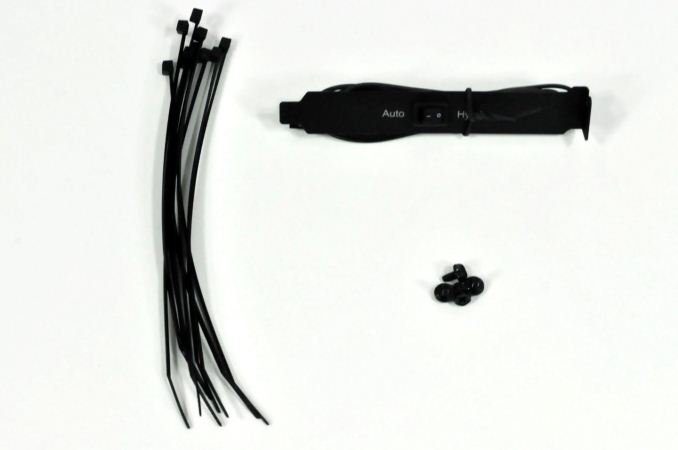Cooler Master V1200 Platinum Power Supply Review
by E. Fylladitakis on November 21, 2014 2:00 PM EST- Posted in
- Cases/Cooling/PSUs
- Seasonic
- 1200W
- Cooler Master

Introduction
Even though 1200 Watts is ludicrously excessive for the typical modern PC, such PSUs are necessary for very advanced or application-specific systems, such as quad-SLI gaming computers and cryptocurrency mining rigs. The market for such equipment is small and very demanding, but succeeding at the top can also affect the reputation of the manufacturer, increasing the sales of their mainstream equipment. This desire to have the best halo product results in strong competition between manufacturers, and it also moves the industry forward as the new technologies developed at the top eventually make their way into mainstream offerings. We had a look at FSP's and Seasonic's offerings, the Aurum PT 1200W and the Seasonic's SS-1200XP3 respectively, a few weeks ago. Today we are reviewing Cooler Master's contender for the 1200W PSU market, the V1200 Platinum.
The main difference between FSP/Seasonic and Cooler Master is that the former are ODMs (Original Design Manufacturers) -- they design, manufacture, and sell their own products. Cooler Master on the other hand has no such capability; their products are generally based on someone else's design (with tweaks and component choices made by Cooler Master), and this ODM also undertakes their manufacturing. This includes the V1200 Platinum, which the company hopes will compete in the top segments of the PSU market.
As its name suggests, the V1200 Platinum is an 80 Plus Platinum certified power supply capable of 1200W of continuous output. However, any advanced user knows that these figures alone mean little regarding the actual quality and performance of a PSU. We are going to closely examine the efficiency, power quality, and thermal performance of the Cooler Master V1200 Platinum in this review and, more importantly, see where it stands in relation to the competition.
| Power specifications ( Rated @ 50 °C ) | |||||
| AC INPUT | 100 - 240 VAC, 50 - 60 Hz | ||||
| RAIL | +3.3V | +5V | +12V | +5Vsb | -12V |
| MAX OUTPUT | 25A | 25A | 100A | 3A | 0.5A |
| 125W | 1200W | 15W | 6W | ||
| TOTAL | 1200W | ||||
Packaging and Bundle
The packaging of the V1200 Platinum is simple and effective, with a serious, professional artwork theme. The front of the box notes only the most important features of the unit, but more information can be found on the sides and rear of the box. On the back of the box Cooler Master claims that this unit can save you over $450 compared to an 80 Plus Bronze equivalent -- if you have a 1000W system at maximum load powered on 24/7 for five years, that is.
The bundle of the V1200 Platinum is very minimalistic for a top tier product. Cooler Master only supplies the fan profile switch bracket, a few cable ties, and four black screws. There are no cable straps, thumbscrews, or even stickers to be found. Not that this generally matters, as most users looking at buying a top tier PSU typically have plenty of extra thumbscrews around, but it is a bit barebones.
The modular cables are supplied in two separate nylon bags. All of the cables and wires are black and, with the exception of the sleeved ATX cable, all made using ribbon-like "flat" wires. The cables are packed using wire ties, meaning that there are no cable straps to be found here either.














27 Comments
View All Comments
Essence_of_War - Friday, November 21, 2014 - link
Good gracious, that is a LOUD fan!Luscious - Friday, November 21, 2014 - link
Your sound measurements are off.I have this power supply, and at 1200 watts it is quiet.
JarredWalton - Friday, November 21, 2014 - link
What SPL meter did you use, what are the test conditions, what is the precise output load (in watts), and how far from the PSU are you measuring noise? My guess is: you don't have an SPL meter, your PSU is in a closed up case, the load is probably more like 700-900W at most, and you're sitting a few feet away. Remember, input power is not output power, and generating a load of 1200W would require basically four R9 290X GPUs running at max power with a bit of overclocking added in for good measure. There aren't many ways regular PC users would ever have a constant load anywhere near 1200W, and at 800W (which is still a lot for a PC) the noise is quite a bit lower.bebimbap - Friday, November 21, 2014 - link
I love these power supply reviews, esp the value statements in the conclusion. That is exactly how I would think.I especially appreciate the hot tests. They are tests a reasonable consumer could not easily perform at home.
Luscious - Saturday, November 22, 2014 - link
I admire your attempt to uphold your article's credibility, but did you think for a minute that perhaps you received a flawed unit, or compare your results with those of other credible reviews already out prior to publishing your findings?Going into detail here regarding my setup would require a page and a half, however I will say that I was running four 780's pushing near 1200MHz and an overclocked 5960X at 1.25 volts. And that doesn't include the ~100 watts needed by the dozen Bitfenix PWM fans on the rads used to cool all of this. No, this was not in a closed case, the load being pulled from the wall was between 1150 and 1290 watts depending on the job being run, and I was not sitting "a few feet" away as you think I might have been.
In the three reviews listed here, neither mentions this power supply being as loud as your review suggests:
http://www.techpowerup.com/reviews/CoolerMaster/V1...
http://www.kitguru.net/components/power-supplies/z...
http://www.overclock3d.net/articles/power_supply/c...
Galidou - Sunday, November 23, 2014 - link
What kind of an answer is that man, giving links that doesn't even match the message you're sending to the anandtech reviewer?Overclock 3D isn't a full review all he says is that it's quiet, no ambient room temperature no noise mesurement device based on his opinion only. One page review where half of the time on the video speaks about the ripple suppression and the overhype of coolermaster about that.
Techpowerup comes to about the same results from 800 to 1200 watts power usage hovering around 51 to 54dba. Only results that differ a little are lower ambient temperature but again they use a custom anechoic chamber to measure noise that reduces the ambient noises to 20dba which is not normal usage, no one games in an anechoic room and some people are really used to outstanding ambient noise.
Kitguru is the only one with very lower numbers but then again they use THEIR acoustic room, doesn't specify what kind of fan settings they are using and so on.
Three reviews different on their testing methodology and you tell us you have a DOZEN bitfenix fans on the rad plus what other noise around you, no wonder why you think it's quiet, you live in the noise! what's your sound measurement tool? From what I can hear ''I was not sitting "a few feet" away'' your EARS?
Goodbye! Brush up on your reading skills man nice system you have btw.
E.Fyll - Tuesday, November 25, 2014 - link
I will simply comment that do not feel the need to "compare" my results prior to publishing them. And, trust me, I can tell if a unit is "flawed" or not.In the three reviews you mentioned, only one is actual, complete work and its results coincide with mine. Actually, since the floor noise of Techpowerup's setup is significantly lower, the PSU they tested appears to be even louder.
vred - Friday, November 21, 2014 - link
I have Seasonic SS-1200XP3, and its fan is quite loud when the PSU is fully loaded. I replaced it with Corsair AX1500i, and the fan noise is day and night compared to Seasonic - really quiet. My system easily draws 1100-1300 watts with 4 watercooled Titan Black videocards and really allows those PSUs to show what they are capable of.Flunk - Friday, November 21, 2014 - link
"This makes it virtually unsuitable for users with very advanced gaming systems that try to keep them as quiet as possible"Who would that be? Anything that needs a 1200watt power supply isn't going to be quiet. Quad SLI systems are loud, even with liquid cooling.
E.Fyll - Friday, November 21, 2014 - link
Well, it can be entirely quiet, but it will also be very, very expensive.The thing is, sound power and sound pressure are additive figures. This means that if you have a noise source that outputs a total SPL of 50dB(A) and add another device that outputs another 45dB(A) to it, you will have a system with a total SPL of 50+45 dB(A). That's NOT 95dB(A), the scale is logarithmic, so the exact math are X = 10log[(10^5.0)+(10^4.5)] = 51.193 dB(A).
To make things simpler, no, I do not expect that such a powerful system will ever be entirely quiet. You can however build a system that is fairly comfortable for everyday use and gaming without terrible effort. But if you keep adding high noise sources, the total noise output of the system increases and it will sooner or later surpass that "comfort threshold". Ignoring the noise output of a power supply just because the rest of the system "is not quiet anyway" is very logical - a noisy power supply will make the entire system, which already is not quiet, even louder.